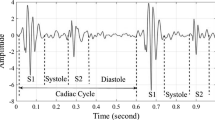Abstract
This paper describes a large resource of multi-center and multi-topic heart sound databases, which were based on the measured data from more than 9,000 heart sound samples (saved in WAV file format). According to different research topics, these samples were respectively stored in different folders (corresponding to different research topics and distributed over various cooperative research centers), most of which as subfolds were stored in a pooled folder in the principal center. According to different research topics, the measured data from these samples were used to create different databases. Relevant data for a specific topic can be pooled in a large database for further analysis. This resource is shared by members of related centers for their own specific topic. The applications of this resource include evaluation of cardiac safety of pregnant women, evaluation of cardiac reserve for children, athletes, addicts, astronauts, and general populations, as well as studies on a bedside method for evaluating cardiac energy, reversal of S1-S2 ratio, etc.

Similar content being viewed by others
References
Weitz, H. H., and Mangione, S., In defense of the stethoscope and the bedside. Am. J. Med. 108(8):669–671, 2000.
Tavel, M. E., Cardiac auscultation: A glorious past–and it does have a future! Circulation. 113(9):1255–1259, 2006.
Xiao, S., Cai, S., and Liu, G., Studying the significance of cardiac contractility variability. IEEE Eng. Med. Biol. Mag. 19(3):102–105, 2000.
Watrous, R. L., Thompson, W. R., and Ackerman, S. J., The impact of computer-assisted auscultation on physician referrals of asymptomatic patients with heart murmurs. Clin. Cardiol. 31(2):79–83, 2008.
Guo, Z., Moulder, C., Zou, Y., Loew, M., and Durand, L. G., A virtual instrument for acquisition and analysis of the phonocardiogram and its internet-based application. Telemed. J. E. Health. 7(4):333–339, 2001.
Wu, W. Z., Guo, X. M., Xie, M. L., Xiao, Z. F., Yang, Y., and Xiao, S. Z., Research on first heart sound and second heart sound amplitude variability and reversal phenomenon–a new finding in athletic heart study. J. Med. Biol. Eng. 29(4):202–205, 2009.
Tuchinda, C., and Thompson, W. R., Cardiac auscultatory recording database: Delivering heart sounds through the Internet. In Proc AMIA Symp. Washington, D.C., pp: 716-720, 2001.
Shao, Y., Zhang, Y. H., Qi, H. B., Xiao, S. Z., and Guo, X. M., Clinical analysis of cardiac reserve function and outcome of preeclampsia. Chinese Journal of Obstetrics and Gynecology 44(10):736–739, 2009 [In Chinese].
Han, F., Yan, H. M., Wei, X. C., and Yan, Q., Effect of mixed anesthesia on cardiac function by phonocardiogram. Journal of Electronic Science and Technology of China 6(1):91–94, 2008.
Wang, W., Yuan, J., and Xiao, S. Z., Value of phonocardiogram exercise test in evaluating the changing tendency of psychological strength in drug addicts. Chinese Journal of Clinical Rehabilitation 8(30):6616–6617, 2004.
Xiao, S., Guo, X., Sun, X., and Xiao, Z., A relative value method for measuring and evaluating cardiac reserve. Biomed Eng Online. Available from: http://www.biomedical-engineering-online.com/content/1/1/6.2002.
Durand, L. G., Langlois, Y. E., Lanthier, T., Chiarella, R., Coppens, P., Carioto, S., and Bertrand-Bradley, S., Spectral analysis and acoustic transmission of mitral and aortic valve closure sounds in dogs. Part 4: Effect of modulating cardiac inotropy. Med. Biol. Eng. Comput. 28(5):439–445, 1990.
Hansen, P. B., Luisada, A. A., Miletich, D. J., and Albrecht, R. F., Phonocardiography as a monitor of cardiac performance during anesthesia. Anesth. Analg. 68(3):385–387, 1989.
Hsieh, B. P., Unver, K., McNulty, E., and Schiller, N. B., The amplitude ratio of the first to second heart sound is reduced in left ventricular systolic dysfunction. Int J Cardiol. 2009. [Epub ahead of print].
Bu, B., Su, Q. S., Sun, J. Z., Zhou, W., and Long, X. A., Research on correlation among cardiac contractility change trend, oxygen uptake and heart rate in human. Sports Science 24(10):35–37, 2004.
Ma, K. H., Ge, P., Lei, H., Liao, H., Wang, Z. H., and Xiao, S. Z., Comparative study of cardiac contractility change trend with maximum elasticity and the clinical application. Chongqing Medical Journal 34(4):571–573, 2005.
Liu, T. H., Liu, J. X., Xiao, S. Z., Yan, M. J., Cai, L., Ying, X. H., and Yan, C. B., A correlation study on cardiac reserve index and ejection fraction for quantifying heart function classification. Sichuan Medicine 26(11):1197–1198, 2005 [In Chinese].
Abe, M., Tomiyama, H., Yoshida, H., and Doba, N., Diastolic fractional flow reserve to assess the functional severity of moderate coronary artery stenoses: Comparison with fractional flow reserve and coronary flow velocity reserve. Circulation 102(19):2365–2370, 2000.
Perloff, J. K., Physical examination of the heart and circulation. In: Braunwald, E. (Ed.), Heart Disease, 5th edition. W. B. Saunders, Singapore, p. 33, 1997.
Cooke, G. A., Marshall, P., al-Timman, J. K., Wright, D. J., Riley, R., Hainsworth, R., and Tan, L. B., Physiological cardiac reserve: Development of a non-invasive method and first estimates in man. Heart 79(3):289–294, 1998.
Smith, C. S., Bottomley, P. A., Schulman, S. P., Gerstenblith, G., and Weiss, R. G., Altered creatine kinase adenosine triphosphate kinetics in failing hypertrophied human myocardium. Circulation 114(11):1151–1158, 2006.
Neubauer, S., The failing heart – an engine out of fuel. N. Engl. J. Med. 356(11):1140–1151, 2007.
Neglia, D., Metabolism, key to understand heart disease-heart failure. ESC 2007 Congress Report. Available from: http://www.escardio.org/knowledge/congresses/congressreports/2007/2992-2995-neglia.htm.
Xie, M. L., Guo, X. M., Xiao, S. Z., Xiao, Z. F., and Yang, Y., A Study of quantification method for heart murmur grading. In: The 4th Int. Conf. on bioinformatics and biomedical engineering, Chengdu, China, in press.
Zhou, Z. N., Zhuang, J. G., Wu, X. F., Zhang, Y., and Cherdrungsi, P., Tibetans retained innate ability resistance to acute hypoxia after long period of residing at sea level. J. Physiol. Sci. 58(3):167–172, 2008.
Acknowledgments
The corresponding author Shouzhong Xiao receives grant support from National Natural Science Foundation of China (NO.30770551).
Author information
Authors and Affiliations
Corresponding author
Rights and permissions
About this article
Cite this article
Xie, M., Xiao, S., Liu, T. et al. Multi-center, Multi-topic Heart Sound Databases and their Applications. J Med Syst 36, 33–40 (2012). https://doi.org/10.1007/s10916-010-9443-x
Received:
Accepted:
Published:
Issue Date:
DOI: https://doi.org/10.1007/s10916-010-9443-x




